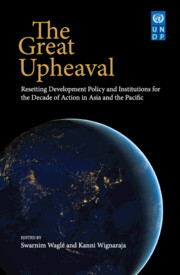Book contents
- Frontmatter
- Contents
- List of Figures
- List of Tables
- List of Boxes
- List of Appendices
- List of Abbreviations
- Foreword
- Acknowledgements
- Introduction
- 1 Aligning Sovereign Debt Financing with Climate Action in the Asia-Pacific Region
- 2 Melting Glaciers, Threatened Livelihoods: Confronting Climate Change to Save the Third Pole
- 3 Accelerating Universal Digital Connectivity
- 4 The Post-COVID-19 Future for Global Value Chains
- 5 Is Southeast Asia Falling into a Latin American–Style Middle-Income Trap?
- 6 Equality of Opportunity as a Measure of Development
- 7 Insights for Policymaking from the Multidimensional Poverty Index
- 8 COVID-19 and Human Security
- 9 Making COVID-19 Vaccine Universally Accessible
- 10 Enhancing the Provision of Global Public Goods: Ready for More Realism?
- 11 Asian-Pacific Regional Cooperation in the Post-COVID-19 Era
- 12 Pandemic Governance and Human Development: Early Lessons from Asia
- 13 Seven Lessons for Development Policy from the COVID-19 Pandemic
- About the Contributors
- Index
2 - Melting Glaciers, Threatened Livelihoods: Confronting Climate Change to Save the Third Pole
Published online by Cambridge University Press: 28 February 2022
- Frontmatter
- Contents
- List of Figures
- List of Tables
- List of Boxes
- List of Appendices
- List of Abbreviations
- Foreword
- Acknowledgements
- Introduction
- 1 Aligning Sovereign Debt Financing with Climate Action in the Asia-Pacific Region
- 2 Melting Glaciers, Threatened Livelihoods: Confronting Climate Change to Save the Third Pole
- 3 Accelerating Universal Digital Connectivity
- 4 The Post-COVID-19 Future for Global Value Chains
- 5 Is Southeast Asia Falling into a Latin American–Style Middle-Income Trap?
- 6 Equality of Opportunity as a Measure of Development
- 7 Insights for Policymaking from the Multidimensional Poverty Index
- 8 COVID-19 and Human Security
- 9 Making COVID-19 Vaccine Universally Accessible
- 10 Enhancing the Provision of Global Public Goods: Ready for More Realism?
- 11 Asian-Pacific Regional Cooperation in the Post-COVID-19 Era
- 12 Pandemic Governance and Human Development: Early Lessons from Asia
- 13 Seven Lessons for Development Policy from the COVID-19 Pandemic
- About the Contributors
- Index
Summary
INTRODUCTION
Earth's third largest storage of frozen water after Antarctica and the Arctic lies in the high mountains of Asia. This has prompted the region's nickname: the Third Pole. Centred on the Tibetan Plateau, this region contains every peak on Earth taller than 7,000 metres. The Himalayan arc flanks the region's south, starting from northern Myanmar in the east, spanning several thousand kilometres (km) to the southern edge of the Tibetan Plateau, the northern edge of northeast India, and across Bhutan, Sikkim, Nepal and the western Himalayan states of India. Separated from the Western Himalaya by the arid Ladakh Valley, the Karakoram range extends north-westwards, connecting to the Hindu Kush Mountains on the Afghanistan–Pakistan border. Together these ranges form the Hindu Kush Karakoram Himalaya (HKH). The Hengduan and Quilian Mountains sit at the eastern side of the Tibetan Plateau, with the Kunlun on the northwest and north. The Pamir Mountains extend north from the Hindu Kush, shared by Afghanistan, China, Kyrgyzstan and Tajikistan. Further north are the Tien Shan Mountains, shared by China, Kazakhstan and Kyrgyzstan, and extending eastwards around the northern edge of the arid Tarim Basin. Figure 2.1 shows a map of High Mountain Asia and its sub-regions.
High Mountain Asia's frozen water, its cryosphere, is stored in several different forms, including in snowfields, glaciers, permafrost and seasonal ice on lakes and rivers. In 2015, glaciers covered almost 100,000 square km3 of High Mountain Asia, containing 3,000-4,700 cubic km of ice (Bolch et al., 2019), with just under half in the Himalaya and Karakoram (Nie et al., 2021). During winters, large parts of High Mountain Asia experience snowfall, while many lakes and high altitude stretches of rivers freeze. When glaciers retreat, vacated depressions often fill with water, forming glacial lakes. The exact number of glacial lakes is not firmly established, and varies in time; estimates range from 4,260 to 8,200 for the HKH region, including 1,466 to 2,323 lakes in Nepal alone (Bolch et al., 2019).
- Type
- Chapter
- Information
- The Great UpheavalResetting Development Policy and Institutions in the Asia-Pacific, pp. 39 - 73Publisher: Cambridge University PressPrint publication year: 2022



